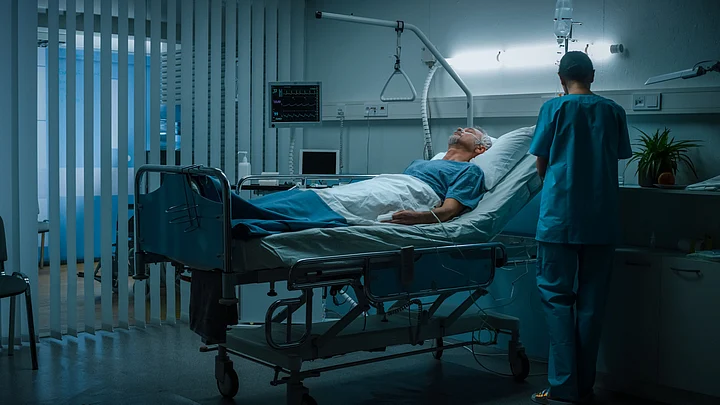Close to half the deaths recorded in the year 2020 – the year when the COVID-19 pandemic began – occurred in the absence of medical attention, data released by the government on Tuesday, 3 May, showed.
Over 45 percent of people died without receiving medical care, which is the highest percentage of this statistic on record.
The numbers published by the government were recorded by the Civil Registration System (CRS) – a "universal, continuous, compulsory, and permanent recording of birth, death and stillbirth" in the country.
Further, while the vital data indicated a decrease in the number of recorded deaths in healthcare centres, including hospitals, the total number of deaths in 2020 increased by 4.75 lakh from the previous year. This denotes a 6.2 percent increase.
2020: The First Year of the Pandemic
The pandemic had a pervasive impact on India's healthcare infrastructure and availability of medical services. It evinced paucity of hospital beds and ambulances in 2020 and the dire shortages of oxygen and ventilators across the country amid the second wave in 2021.
When the country first witnessed the health emergency, COVID-positive patients, or people with other ailments, or even expecting women faced unavailability of these essential services.
With a huge number of beds being reserved in light of the coronavirus, several people with differing medical ailments failed to get access to adequate medical services.
The CRS data released on Tuesday reflected the realities of the unprecedented year, as the proportion of people dying in the absence of medical attention increased by over 10 percent, from 34.5 percent in 2019 to 45 percent in 2020.
In 2010, this figure had been only 10 percent.
The CRS Data on Deaths in 2020
While the system saw 76.4 lakh registered deaths in 2019, over 81.2 lakh people died on record in 2020. These include deaths due to the COVID-19 health emergency, as well as other causes.
Of the total registered deaths, the share of males and females is 60.2 percent and 39.8 percent, respectively.
According to the data shared by the Ministry of Health and Family Welfare, COVID-19 was responsible for 1,48,994 deaths in 2020. The number increased to 3,32,492 in 2021.
Meanwhile, a draft report by the Medical Certification of Cause of Death (MCCD) demonstrated that of 18,11,688 medically certified deaths, 1,60,618 have been certified as COVID deaths in 2020, news agency ANI reported.
While several states saw an increase in their annual death rates in 2020, some states like Manipur, Chandigarh, Telangana, Uttar Pradesh, Uttarakhand, Arunachal Pradesh, and Kerala reported a fall in their mortality rates.
Of the states that recorded a spike, Bihar recorded the highest increase in its death rate with 18.3 percent, followed by Maharashtra with 16.6 percent and Assam with 14.7 percent.
Others states that witnessed these upswings were Gujarat, Andhra Pradesh, West Bengal, Nagaland, Haryana, Karnataka, Tamil Nadu, Sikkim, Punjab, Madhya Pradesh, Odisha, and Rajasthan. Among the UTs, Andaman & Nicobar island saw an upswing.
CRS Data on Births
The yearly report on Vital Statistics of India also recorded birth rate in the country, which fell to 73.7 percent in 2020.
The number of registered births in 2020 were 2.42 – a decrease from 2.48 births in the previous year. Out of these, the share of males and females was recorded to be 52.0 per cent and 48.0 per cent, respectively.
Lakshadweep, however recorded an increase of 14.3 percent, followed by Haryana at 11.7 percent and Bihar at 8.4 percent.
Meanwhile, Nagaland, Telangana, Manipur, Delhi, Arunachal Pradesh, West Bengal, Kerala, Gujarat, Karnataka, Himachal Pradesh, Uttar Pradesh, Assam, Tamil Nadu, Uttarakhand, Maharashtra, and Mizoram recorded a decrease in the registered birth rate.
The data also demonstrated that 15 States and union territories, namely Gujarat, Puducherry, Tamil Nadu, Chandigarh, Lakshadweep, Mizoram, Dadra and Nagar Haveli and Daman & Diu, Punjab, Haryana, A & N Islands, Himachal Pradesh, Odisha, Goa, West Bengal, and Andhra Pradesh had registered over 90 percent of the total births registered in the stipulated period of 21 days.
Meanwhile, Uttar Pradesh, Manipur, Uttarakhand, Ladakh, Assam, Arunachal Pradesh, and Nagaland saw the registration of less than or equal to 50 percent of total registered births.
What is the CRS?
The annual registration of of births, deaths and stillbirths was made mandatory by law with the enactment of the the Registration of Births and Death Act (RBD Act), 1969.
The legislation sought to bring uniformity and track the registration of birth and death in the nation.
Last week, the Ministry of Home Affairs (MHA) introduced changes in the CRS to address challenges such as inefficiency and disparity in registration, which led to delayed under-coverage of births and deaths in the country.
While the central government coordinates and unified the process through the Registrar General, India (RGI), at the national level, state governments are entrusted with the responsibility to implement the exercise. The state governments, in turn, appoint functionaries who register births and deaths in the country.
In each state and Union Territory, the directorates of Census Operations, which are sub-ordinate to the RGI, carry out the monitoring of this task.
(With inputs from ANI and The Indian Express.)
